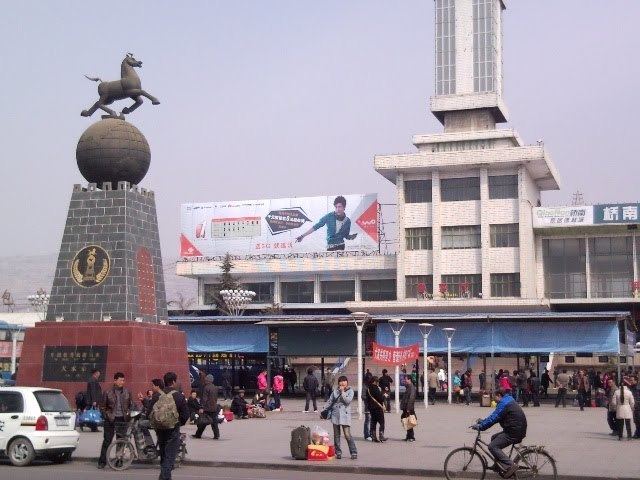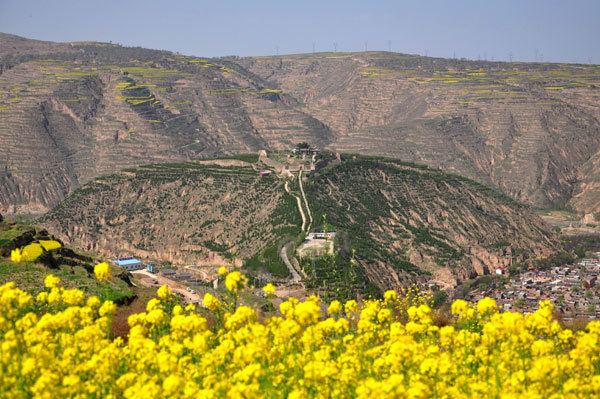Country China Population 1.147 million (2000) | Area 14,300 km2 | |
 | ||
Map of Tianshui
Tianshui is the second-largest city in Gansu Province, China. Its population is approximately 3.5 million. The city and its surroundings have played an important role in the early history of China, as still visible in the form of historic sites.
Contents
- Map of Tianshui
- Tianshui gansu
- History
- Geography
- Economy
- Airlines
- Railway
- Highways
- Tourism
- Education
- References

Tianshui gansu
History
Qin, whose House of Ying were the founding dynasty of the Chinese empire, developed from Quanqiu (present-day Lixian) to the south. After the invasions of the Rong which unseated the Western Zhou, Qin recovered the territory of Tianshui from the nomads. It became an important region of their duchy and, later, kingdom. Characteristically Qin tombs have been excavated at Fangmatan nearby, including one 2200-year-old map of Qin's Gui County.
Under the Qin Empire, the area was part of Longxi Commandery but the Emperor Wu of the Han separated the region as the Tianshui Commandery as part of his expansion towards the Tarim Basin. The general Li Guang came from the city. The Han conquests and explorations eventually resulted in the development of the Northern Silk Road: Tianshui formed its junction with the Wei River, after which it followed the road past Mount Long to Chang'an (present-day Xi'an). Nearby are the Maijishan Grottoes, filled with thousands of Buddhist sculptures representing figures such as Buddha and the original male form of Guanyin, produced between the Wei and Song dynasties by monks travelling along the road and by local Buddhists.
During the Northern Wei, the city was known as Hanyang and was the center of the Hanyang Commandery. During the Western Wei, this name was changed to Hanyang County. During the Tang and Five Dynasties, the city of Tianshui was known as Shanggui (上邽). It alternated with Chengji (present-day Qin'an) as the capital of the province of Qinzhou (秦州). Li County was separated from Tianshui's jurisdiction during the ninth year of Chenghua (AD 1473) during the Ming dynasty.
Under Qinzhou's former romanization of Tsinchow, Tianshui is a (currently vacant) diocese (Latin: DIŒCESIS ZINCEUVENSIS) of the Roman Catholic church.
Geography
Tianshui is located in the valley of the Jie River, a major tributary of the Wei River. The city has a monsoon-influenced, cool semi-arid climate (Köppen BSk), with four distinct seasons of comparatively equal length. Winters are cold but dry, with January 24-hour average temperature of −2.0 °C (28.4 °F), while summers are warm and somewhat humid, with July 24-hour average temperature of 22.8 °C (73.0 °F). Much of the annual rainfall occurs from June to September, and the annual mean temperature is 11.00 °C (51.8 °F). With monthly percent possible sunshine ranging from 34% in September to 50% in December, the city receives 1,911 hours of bright sunshine annually.
Economy
Tianshui is a major industrial centre in Gansu province. Some major industries include:
Airlines
Tianshui Maijishan Airport is located near the built up area.
Railway
Tianshui is currently serviced by Tianshui Station along the Longhai Railway.
A new high-speed railway station, Tianshui South Railway Station, is under construction and expected to open late 2017.
Highways
The G30 Expressway connect Tianshui to Baoji/Xi'an in the east and Dingxi,Lanzhou towards the northwest and supersedes highway G310. G310 runs as a grade separated through road within the urban centre.
